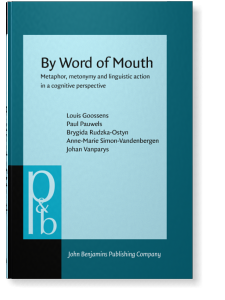By Word of Mouth
Metaphor, metonymy and linguistic action in a cognitive perspective
This volume contains seven synchronic and diachronic empirical investigations into the expression and conceptualization of linguistic action in English, focusing on figurative extensions. The following issues are explored:
- Source domains, and their relation to the complexities of linguistic action as a target domain.
- The role of axiological parameter, the experiential grounding of metaphors expressing value judgements and the part played by image-schemata, how value judgements come about and their socio-cultural embedding.
- The graded character of metaphoricity and its correlation with degrees of recoverability/salience.
- The interaction of metonymy and metaphor, e.g. the question what factors motivate the conventionalization of metonymies, which includes the perspective that conventionalized metaphors frequently have a metonymic origin.
- The role of image-schemata in the organization and development of a lexical subfield, which raises new questions on the nature of metaphor, the identification of source and target domains and the Invariance Hypothesis.
[Pragmatics & Beyond New Series, 33] 1995. xii, 254 pp.
Publishing status: Available
© John Benjamins Publishing Company
Table of Contents
-
Introduction | p. vii
-
A survey of Metalinguistic MetaphorsJohan Vanparys | p. 1
-
Body Parts in Linguistic Action: Underlying Schemata and Value JudgementsPaul Pauwels and Anne-Marie Simon-Vandenbergen | p. 35
-
Assessing Linguistic Behaviour: A Study of Value JudgementsAnne-Marie Simon-Vandenbergen | p. 71
-
Levels of Metaphorization: The Case of PutPaul Pauwels | p. 125
-
Metaphonymy: The Interaction of Metaphor and Metonymy in Figurative Expressions for Linguistic ActionLouis Goossens | p. 159
-
From Three Respectable Horses’ Mouths: Metonymy and Conventionalization in a Diachronically Differentiated Data BaseLouis Goossens | p. 175
-
Metaphor, Schema, Invariance: The Case of Verbs of AnsweringBrygida Rudzka-Ostyn | p. 205
-
-
Subject Index | p. 251
“The empirical depth to which this volume examines one coherent area of metaphorization in English, including theoretical and historical discussion, is a true benefit to the maturation of Cognitive Linguistics.”
James Fife, Word 49:2 (98)
Cited by (29)
Cited by 29 other publications
Chen, Xi
Xi, Rui
Ananieva, Nika
Ferrerós-Pagès, Carla
Golubkova, E. E. & E. B. Kivileva
Zhang, Cun & Charles Forceville
2020. Metaphor and metonymy in Chinese and American political cartoons (2018–2019) about the Sino-US trade conflict. Pragmatics & Cognition 27:2 ► pp. 474 ff. 
MICHL, DIANA
Barcelona, Antonio, Olga Blanco Carrión & Rossella Pannain
Liu, Feifei
Pannain, Rossella
2018. Chapter 9. The mouth of the speaker. In Conceptual Metonymy [Human Cognitive Processing, 60], ► pp. 237 ff. 
Sepideh, Hozhabrossadat
Ansah, Gladys Nyarko
Glynn, Dylan
2014. Polysemy and synonymy. In Corpus Methods for Semantics [Human Cognitive Processing, 43], ► pp. 7 ff. 
Glynn, Dylan
2014. Techniques and tools. In Corpus Methods for Semantics [Human Cognitive Processing, 43], ► pp. 307 ff. 
Roldán-Riejos, Ana & Paloma Úbeda-Mansilla
Wang, Wei
2013. Review of Xiufang (2011): 词汇化:汉语双音词的衍生 和发展. Chinese Language and Discourse. An International and Interdisciplinary Journal 4:1 ► pp. 149 ff. 
Hernández-Guerra, Concepción
Deignan, Alice
Abbott, Christine & Philip Eubanks
Gibbs Jr., Raymond W.
Semino, Elena
Steen, Gerard
Danesi, Marcel
Ibarretxe-Antuñano, Iraide & Brigitte Nerlich
Patton, Laurie L.
Vanparys, Johan
This list is based on CrossRef data as of 18 july 2024. Please note that it may not be complete. Sources presented here have been supplied by the respective publishers. Any errors therein should be reported to them.
Subjects
Main BIC Subject
CF: Linguistics
Main BISAC Subject
LAN009000: LANGUAGE ARTS & DISCIPLINES / Linguistics / General
